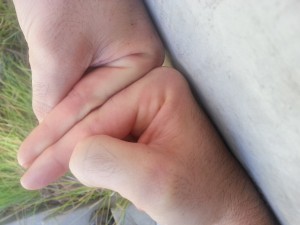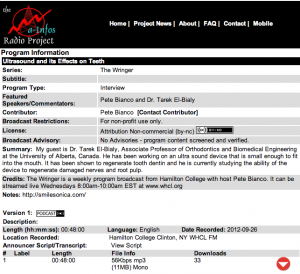Last time it looked as though my right finger which I loaded via LSJL was about 1/4″ longer. Now it looks like it’s about .375″ inches longer. I’ve been loading about every day for about a 100 count on each of the three joints of the finger. I increase the load as fast as possible, I could do more but I worry about injury because the clamp is so much stronger than the finger. I might work up to more. Two joints I load side to side but since the hand is in the way for the knuckle I load from top to bottom. Here’s a post regarding my previous results and some images about how I perform LSJL. Here’s an image of my fingers now:  Now it’s an extremely significant increase in finger length that is a result of LSJL. Now I do have some osteophytes and the finger growth is not the same as normal finger growth. In some of the other images you can see some finger deformities relative to a normal finger. But it’s still a strong proof of concept that LSJL works to lengthen long bones. I’d rather prove LSJL sooner rather than later. Would x-rays help? I don’t really want to get them if they won’t convince people because it would cost a couple hundred dollar. A lot of people don’t know exactly what makes you taller. They can’t connect that long bones make you taller and the finger bones are long bones. If LSJL can increase the length of finger bones(which are long bones(although they do have some different properties to other long bones)) then LSJL can increase overall height if those long bones are legs. As far as my leg progress though, I find that I can’t get as intense a clamp on my knees as I can on my fingers. I think part of the reason is that there’s a lot of tissue types you’re clamping when you clamp a synovial joint. It may take a bit of time before these tissues adapt to the clamping force. I’ve been clamping for a long time with the C-clamp but there was a lot of slippage so there’s now a lot more force with the Irwin Quick Grip that i’m used to. So right now I’m clamping with the Irwin Quick Grip to about a count of 130 before the pain in the soft tissues is just too irritating but over time the soft tissues will adapt and I’ll be able to clamp with as much force as I want as I have with bones I’ve been clamping a long time. So I’d recommend not clamping past the point of too much soft tissue pain and just try to increase clamping duration and intensity over time to allow the soft tissues to adapt. Remember, that LSJL is untested so there are guarantees that you won’t get injured or other maladies. Of course, if we could just prove LSJL then more testing can be done. The question is how can we do it now rather than having to perfect it to increase leg length first?
Now it’s an extremely significant increase in finger length that is a result of LSJL. Now I do have some osteophytes and the finger growth is not the same as normal finger growth. In some of the other images you can see some finger deformities relative to a normal finger. But it’s still a strong proof of concept that LSJL works to lengthen long bones. I’d rather prove LSJL sooner rather than later. Would x-rays help? I don’t really want to get them if they won’t convince people because it would cost a couple hundred dollar. A lot of people don’t know exactly what makes you taller. They can’t connect that long bones make you taller and the finger bones are long bones. If LSJL can increase the length of finger bones(which are long bones(although they do have some different properties to other long bones)) then LSJL can increase overall height if those long bones are legs. As far as my leg progress though, I find that I can’t get as intense a clamp on my knees as I can on my fingers. I think part of the reason is that there’s a lot of tissue types you’re clamping when you clamp a synovial joint. It may take a bit of time before these tissues adapt to the clamping force. I’ve been clamping for a long time with the C-clamp but there was a lot of slippage so there’s now a lot more force with the Irwin Quick Grip that i’m used to. So right now I’m clamping with the Irwin Quick Grip to about a count of 130 before the pain in the soft tissues is just too irritating but over time the soft tissues will adapt and I’ll be able to clamp with as much force as I want as I have with bones I’ve been clamping a long time. So I’d recommend not clamping past the point of too much soft tissue pain and just try to increase clamping duration and intensity over time to allow the soft tissues to adapt. Remember, that LSJL is untested so there are guarantees that you won’t get injured or other maladies. Of course, if we could just prove LSJL then more testing can be done. The question is how can we do it now rather than having to perfect it to increase leg length first?
Michael: The finger seems to be definitely longer, but you said that you clamped in all three joints.
- Does that mean that the clamping was also at metacarpophalangeal joints?
- How did you do that, and how can we not make sure that the MSP Joint did not go into inflammation mode aka swelling?
- There is so much evidence that finger joints can swell up if you hit them on something.
X-Rays seem to be the way to go. We measure the synovial joints of the index finger of the right hand compared to the control of your left hand’s index, which I hoped was never clamped, and see whether the lengthen is from the tissue in the synovial joints thickening as a response. If there is a difference in the distance between the bones in either the PIP and/or MCP joints, then the lengthening was not bone. If the distance in the PIP & MCP joint locations are the same, then we then say that the lengthening was truly bone.
You don’t have to go in for a GP check-up. Look into Urgent Care Centers (Source: Which is Cheaper Out of Pocket: Urgent Care Facility or Hospital ER?). They usually accept Insurance. I’ll even put down $70 for the X-rays if that helps.


